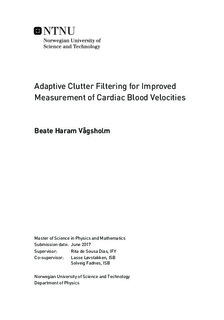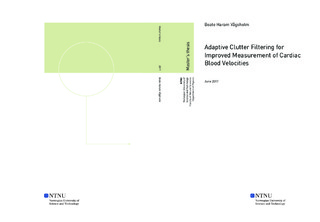| dc.description.abstract | In ultrasound color flow images of the heart, irregular blood flow patterns might be an early indication of heart disease. The blood flow is possible to image using multi-dimensional blood velocity estimation like speckle tracking. In order to image the blood flow, the signal from the surrounding tissue must be attenuated, and this is often termed clutter filtering. Insufficient clutter filtering might cause bias in the velocity estimation. It is difficult to design filters with a fixed cut-off frequency for cardiac imaging since the blood and clutter velocity changes during the heart cycle. A possible solution to avoid both tissue flashing and blood signal drop-out is to use adaptive filters. Eigenvalue regression filters are one type of adaptive clutter filters, and in this work, it was investigated if clutter filtering of cardiac data was yet another suitable application for eigenvalue regression filters.
Selection of a clutter subspace is a challenge when using eigenvalue regression filters. In
this work, the clutter subspace was chosen manually, and by using a previously suggested semi-automatic approach, and two fully automatic approaches. Analyzed datasets included in vivo data, and simulations. The eigenvalue regression filter with a manually selected clutter subspace has the possibility of improving the visualization of vortex formation in blood compared to a conventional filter for cardiac data. However, the improvement was not judged by clinicians, and only five different frames were considered. These frames were from three different in vivo datasets.
The results from the simple simulations showed that the eigenvalue regression filter can reduce the bias in the velocity estimate from speckle tracking compared to a FIR filter, as it reduces tissue flashing, and blood signal drop-outs.
The semi-automatic approach select the clutter subspace most correctly out of the three
methods considered in this work. It was correct in 44% of the frames in diastole, but only one frame from nine different datasets were considered. The semi-automatic approach is not a practical solution since a region containing clutter and blood signals must be chosen manually. | |

